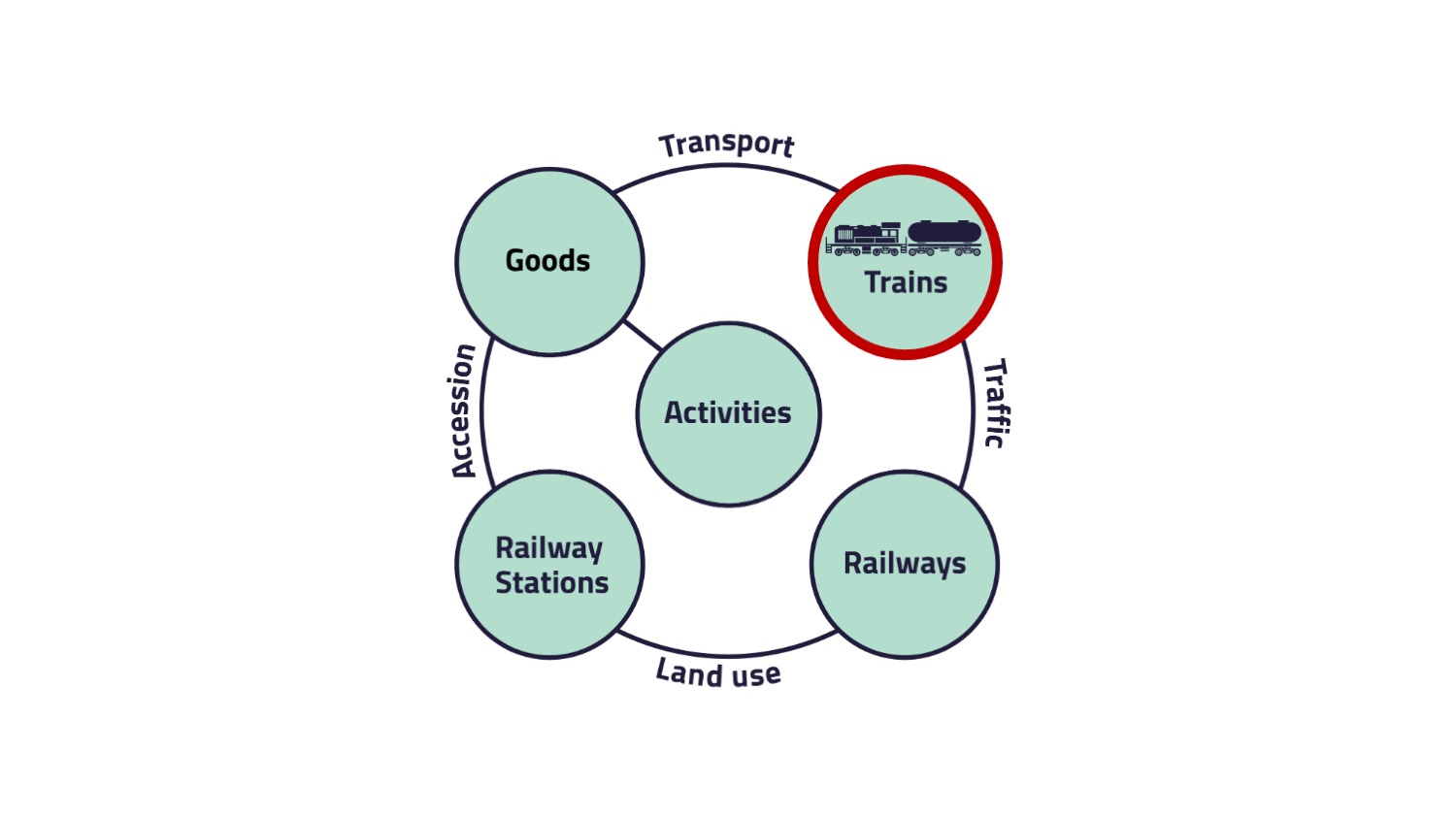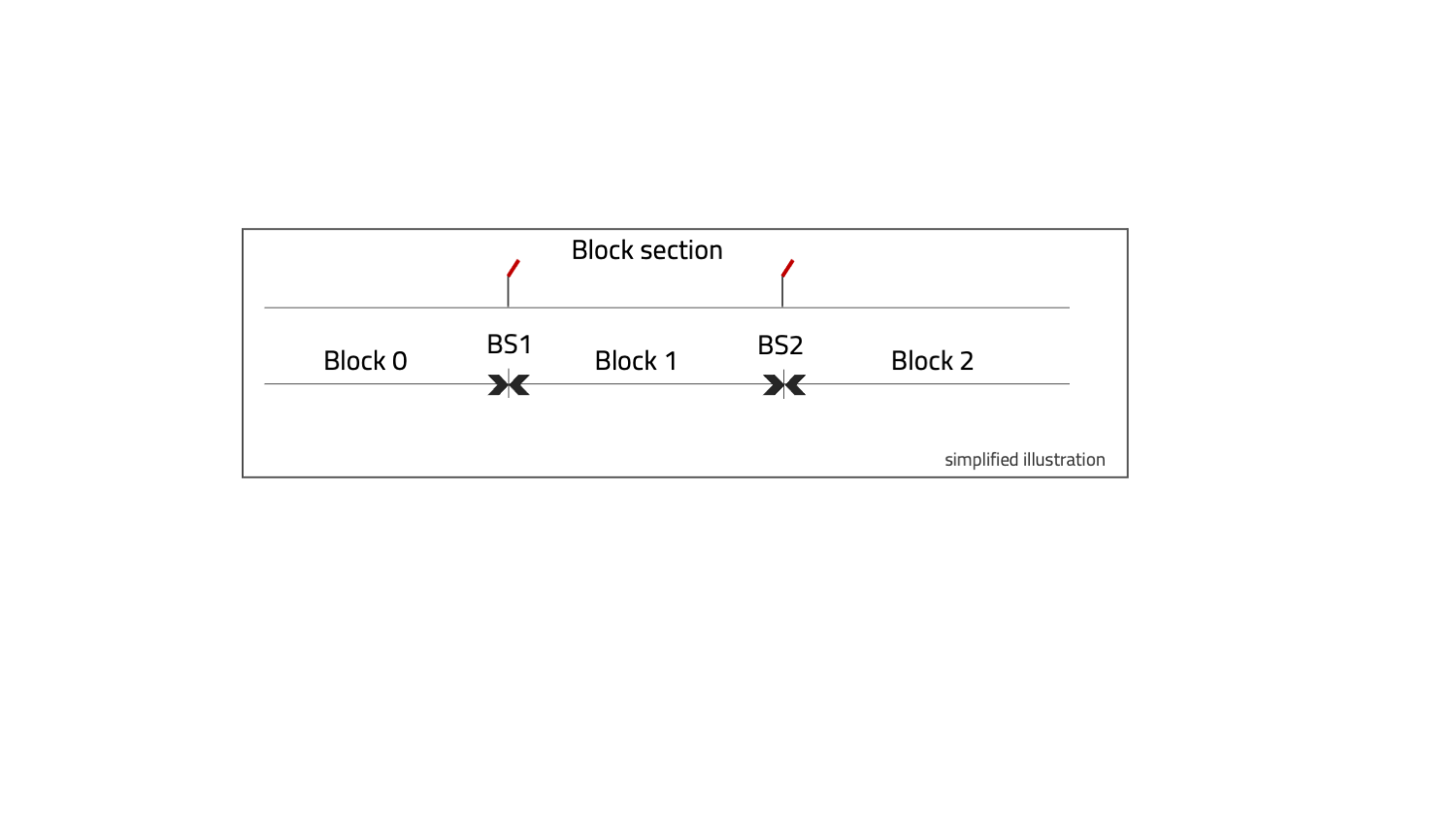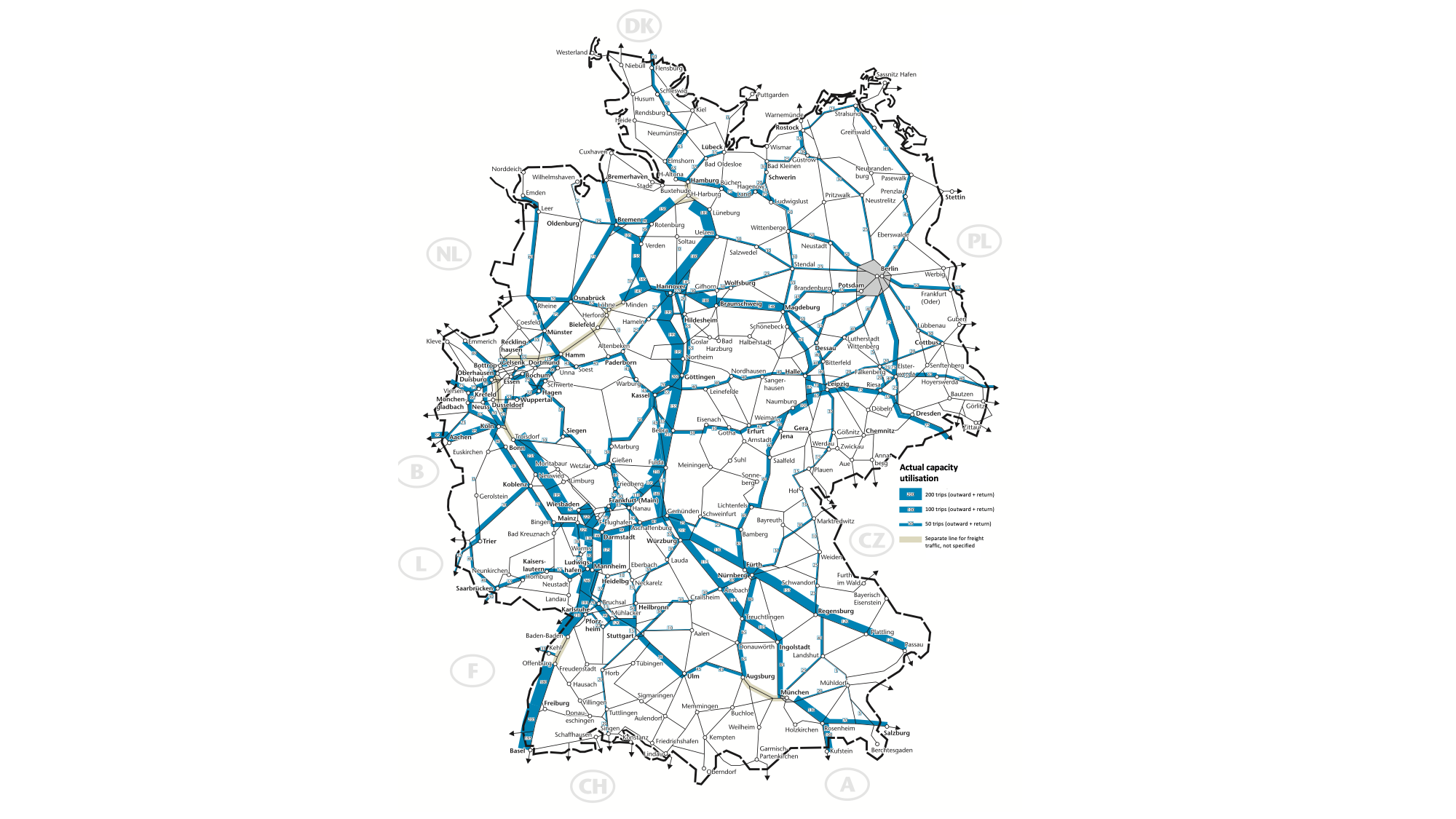Rail Transport System
4. Trains
On this page, the element "Trains" is introduced. We will discuss different types of trains and traffic volumes. In addition, we will show you, in which different ways trains are operating.

The type of the transported goods determines the decision for the type of train wagon being used. Some types of train wagons are presented to you in the following.
- Type E: Open Top Freight Wagon
- 2-axle and 4-axle
- open, solid, high-resistance box wagon
- The wagon can be loaded from the top using mechanized loading devices.
- This freight wagon is designed for the transport of weather-resisting bulk materials: Coal, ore, crushed rocks, etc.
- Type F: Open Hopper Wagon (Bulk freight wagon)
- The wagon takes advantage of gravity to unload its contents through two pairs of bottom doors.
- The self-unloading wagon is designed to transport sand, stone and other aggregate materials.
- Type H: High Capacity Sliding Wall Wagon
- A wagon with sliding walls, which permits easy side loading and unloading with forklifts.
- The wagon is best suited to transport paper coils, cellulose, sawn timber, sheets of plywood and goods on palettes.
- Type K: 2-axle Flat Wagon
- The wagon can be loaded and unloaded from the top and via side ramps.
- Materials can be protected against the weather by a waterproof tarpaulin.
- Type R: 4-axle bogie flat wagon
- This freight wagon is designed for the transport of heavy loads of packaged materials or long loads, such as steel pipes, profiles or lumber.
- Type S: 6-axle bogie flat wagon
- This freight wagon is particularly for heavy loads.
- Type T: Covered Hopper Wagon (Bulk freight wagon)
- The wagon with swivel or roll roof and sidewall doors for heavy cargo.
- Type T: Wagon with opening roof
- This freight wagon is particularly suitable for weather-sensitive goods.
- Type U: Tank wagon for forced air pressure discharge
- This freight wagon is specifically for the transport of powdery, granular goods.
- Type Z: Tank wagon
- This freight wagon is for the transport of liquids and gases.
- Type L: Car Carrier Wagon
- This freight wagon is designed to transport automobiles and vans.
- Combined Transport
- Large containers and swap bodies
Some of the presented train wagons are shown in the figure "Train wagons".
When the trains are using the railways, rail traffic is generated. Now that you've learned about the different types of wagons, let's look at the traffic and what types of traffic exist.
Traffic
Rail freight transport in port-hinterland traffic is dominated by block trains. These are often bulk goods transports from mining areas or agricultural regions.
In Germany, these are usually combined transports in which containers are transported on trains. For geographical reasons, these transports in Europe and especially in Germany take place on the north-south axis. For this reason, the route loads are highest on these routes.
In Germany - as in many other countries in the world - rail transports take place on the same infrastructure as passenger transport, but since the 1990s with separate trains. This situation often leads to capacity overload and possible transport delays on certain routes.
In Germany for example, the regulations of the German train composition standards (Güterzugbildungsvorschrift (GZV)) for freight train formation are defining the following:
- For safety reasons, railway lines are divided into sections known as blocks.
- Normally, only one train is permitted in each block at a time.
- The train length influences the block allocation.
- The permissible maximum (total) train length is 740 metres; this corresponds to about 35 wagons (railcar length of 700 metres without driven head unit) and/or
- a regular train has a maximum of 250 axes. Under certain conditions it is up to 252 axes or/and
- the maximum permissible axle load is 22.5 t and/or the towing weight is 2,500 t.

The described regulations fit most of the train compositions. Sometimes, the trains do not meet the specifications and in some cases, it can have a positive impact on the traffic flow, if the trains are longer, for example. For these reasons, some exceptions exist in terms of weight or length for freight train compositions.
Exceptions for freight train compositions are:
- Bulk freight trains with special operational treatment up to 5,000 t.
- November 2008: For the first time, a 1,000 m freight train ran between Oberhausen and Rotterdam (Betuwe Route in the Netherlands only for freight trains).
- 2012: Freight trains between Padborg (DK) and Maschen (GER) with a length of 835 m (40 wagons), expanded 2016 to the Port of Hamburg (Hohe Schaar).
- In order to operate a train that exceeds the normal dimensions, some adjustments of infrastructure and operations are required:
- extension of passing tracks
- adjustment of control and safety technology
- extension of block sections
Main traffic corridors of rail freight transport in Germany
The figure "Main traffic corridors of rail freight transport in Germany" shows the main traffic corridors of rail freight transport in Germany. It can be seen that a substantial part of rail freight traffic in Germany takes place in a few corridors. There is a high dependency on these main corridors and if they are not optimally managed or treated, this can have a negative impact on the growth opportunities of rail.

It can be seen, that the traffic is mainly on the North-South Axis and that seaport-hinterland traffic has a strong influence. The two main corridors in Germany are the:
- Rhine Graben: ARA-ports (Amsterdam-Rotterdam-Antwerp)-Duisburg-Koblenz-Mainz-Mannheim-Karlsruhe-Basel
- North-south route: Hamburg-Hanover-Fulda-Würzburg-Munich-Brenner (incl. Würzburg-Nuremberg-Passau-Vienna)
As mentioned above, different types of trains are used for rail traffic. In the following, we will discuss block trains, combined transport and single wagonload traffic.
Let’s start with the block train:
Block train
Block trains are complete trains, containing goods of one client, transported from point A to point B. The train does not need to be stopped for shunting procedures. Block trains require a large transport volume and are realized both in own-account transport and between major hubs in combined transport.
The advantages of block trains are the following:
Block trains are complete trains, containing goods of one client, transported from point A to point B. The train does not need to be stopped for shunting procedures. Block trains require a large transport volume and are realized both in own-account transport and between major hubs in combined transport.
The advantages of block trains are the following:
- Block trains are the fastest product in the rail system because of the comparatively short transport times without stopping at the marshalling yard.
- The organization of block trains is less complex.
- The coordination of departure and arrival times of block trains is more flexible.
In the following we will give some examples of such block trains.
- DB Cargo AG:
- DBplantrain is planning the transport requirements a long time in advance, leading to a cost-effective planning. It regularly transports large volumes on fixed routes for fixed transport dates and times.
- DBflextrain arranges transport volumes, connections and operating times at short notice, offering a last-minute block train. Customers have maximum flexibility upon order placement.
- NYK Line Amsterdam-Duisburg:
- 80 TEU capacity per train, 6 trains per week (NYK Line)
- Transit time: Amsterdam - Duisburg in 7 hours
- Trans-Sibirian container train for BMW:
- Regular from 2011-2022, this new transport product enabled shorter transport durations for 10,000 -12,000 km of 14-16 days. Compared to maritime transport, only half the time is needed.
- 75% cost advantages in comparison to air transport, but 50% above costs for maritime transport.
- 400 trains with 35,000 containers in 2015
- Use of customer specific trains as "dedicated company trains“
- E.g. Trans-Siberian container train for BMW from Leipzig to Shenyang
In contrast to block trains, rail traffic can also be operated with single wagonload traffic.
Single wagonload traffic
In single wagonload traffic, individual wagons are loaded with goods at various locations and are then transferred to and sorted at marshalling yards. They are transported to the destination marshalling yard, where the individual wagons are separated. The customers use single wagons exclusively. Single wagonload traffic is a good option, if the customer wants to dispatch one or several wagons at the time but does not have enough quantity for a block train. It is more expensive and time-consuming than block trains because of the train composition and integration in the timetable and the multiple handlings of trains from origin to destination.
The advantages of single wagonload traffic are:
In single wagonload traffic, individual wagons are loaded with goods at various locations and are then transferred to and sorted at marshalling yards. They are transported to the destination marshalling yard, where the individual wagons are separated. The customers use single wagons exclusively. Single wagonload traffic is a good option, if the customer wants to dispatch one or several wagons at the time but does not have enough quantity for a block train. It is more expensive and time-consuming than block trains because of the train composition and integration in the timetable and the multiple handlings of trains from origin to destination.
The advantages of single wagonload traffic are:
- available at short notice
- full network coverage in Europe
- flexible management of freight wagon loading and unloading processes
Furthermore, rail transport can be organised as combined transport.
Combined transport
Combined transport is a transport in integrated transport chains using two or more modes of transport. By using combined transport, the specific advantages of each mode of transport can be combined.
Combined transport is a transport in integrated transport chains using two or more modes of transport. By using combined transport, the specific advantages of each mode of transport can be combined.
There are two types of combined transport:
- accompanied combined transport („Rollende Landstraße“ / „rolling highway“)
- unaccompanied combined transport
For the use of the presented trains, a network of railways is necessary. This infrastructure will be presented to you on the next page.
Literature
DB Cargo AG (2022): Ganzzugverkehr: Ihre Wahl für große Mengen. URL: https://www.dbcargo.com/rail-de-de/leistungen/schienentransporte/Ganzzug (last access: 30.03.2022).
DB Netz AG (2016): Seit 2016 verkehren 835 m lange Güterzüge auch aus dem Hamburger Hafen. URL:
https://fahrweg.dbnetze.com/fahrweg-de/kunden/betrieb/laengere_gueterzuege-1393340 (last access: 30.03.2022).
DB Netz AG (2022): Nutzungsbedingungen Netz der DB Netz AG (NBN 2022). URL: https://fahrweg.dbnetze.com/fahrweg-de/kunden/nutzungsbedingungen/nutzungsbedingungen/NBN/Nutzungsbedingungen-Netz-der-DB-Netz-AG-NBN-2022-5674326?contentId=5674324 (last access: 30.03.2022).
Doll, N. (2016): Bahnverbindung Deutschland-China ist eine Erfolgsgeschichte. URL: https://www.welt.de/wirtschaft/article160672317/Bahnverbindung-Deutschland-China-ist-eine-Erfolgsgeschichte.html (last acces: 30.03.2022).
DB Netz AG (2016): Seit 2016 verkehren 835 m lange Güterzüge auch aus dem Hamburger Hafen. URL:
https://fahrweg.dbnetze.com/fahrweg-de/kunden/betrieb/laengere_gueterzuege-1393340 (last access: 30.03.2022).
DB Netz AG (2022): Nutzungsbedingungen Netz der DB Netz AG (NBN 2022). URL: https://fahrweg.dbnetze.com/fahrweg-de/kunden/nutzungsbedingungen/nutzungsbedingungen/NBN/Nutzungsbedingungen-Netz-der-DB-Netz-AG-NBN-2022-5674326?contentId=5674324 (last access: 30.03.2022).
Doll, N. (2016): Bahnverbindung Deutschland-China ist eine Erfolgsgeschichte. URL: https://www.welt.de/wirtschaft/article160672317/Bahnverbindung-Deutschland-China-ist-eine-Erfolgsgeschichte.html (last acces: 30.03.2022).
Flämig, H., Sjöstedt, L., Hertel, C. (2002): Multimodal Transport: An Integrated Element for Last-Mile-Solutions? Proceedings, part 1; International Congress on Freight Transport Automation and Multimodality: Organisational and Technological Innovations. Delft, 23 & 24 May 2002. (modification of Sjöstedt 1996)
Horvath Verlag GmbH (2016): Transsiberian route: DB Cargo remains a partner of BMW. URL: http://www.oevz.com/en/news-en/transsiberian-route-db-cargo-remains-a-partner-of-bmw/ (last access: 30.03.2022).
NYK Logistics Europe Ltd.; Bruun, T.O.; Kühne School (2008): Tagesforum Internationale Transportketten.
Pachl, J. (2013): Systemtechnik des Schienenverkehrs. 7. Auflage. Springer Vieweg Verlag Wiesbaden.
UBA (2010): Schienennetz 2025/2030-Ausbaukonzeption für einen leistungsfähigen Schienengüterverkehr in Deutschland. URL: https://www.umweltbundesamt.de/sites/default/files/medien/461/publikationen/4005.pdf (last access: 30.03.2022).
Verkehrsrundschau (2008): Deutsche Bahn erprobt erstmals 1000-Meter-Güterzug.
URL: https://www.verkehrsrundschau.de/nachrichten/transport-logistik/deutsche-bahn-erprobt-erstmals-1000-meter-gueterzug-3020883 (last access: 30.03.2022).